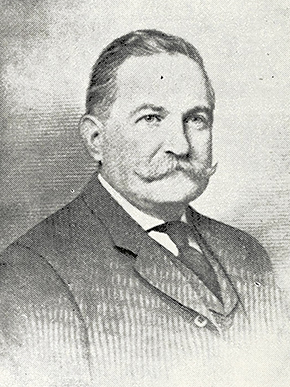Cone, Ceasar
22 Apr. 1859–1 Mar. 1917
 Ceasar Cone, industrialist and philanthropist, was born in Jonesboro, Tenn., the son of Herman and Helen Guggenheimer Cone. The parents were natives of Bavaria, born about ten miles apart but unacquainted until they met in Richmond, Va., where they were married in 1856. Herman Cone came to the United States in 1847, establishing a mercantile business near Richmond; he soon removed to Jonesboro and established there the same kind of business. In 1870 he moved his family to Baltimore, Md., and established a wholesale grocery business.
Ceasar Cone, industrialist and philanthropist, was born in Jonesboro, Tenn., the son of Herman and Helen Guggenheimer Cone. The parents were natives of Bavaria, born about ten miles apart but unacquainted until they met in Richmond, Va., where they were married in 1856. Herman Cone came to the United States in 1847, establishing a mercantile business near Richmond; he soon removed to Jonesboro and established there the same kind of business. In 1870 he moved his family to Baltimore, Md., and established a wholesale grocery business.
Cone attended the public schools of Baltimore until he was fourteen and then worked briefly in a stationery store and with his father. He and his brother, Moses (whose sketch provides further information), invested in the C. E. Graham Manufacturing Company in Asheville in 1887. Herman Cone's wholesale grocery firm closed in 1890 after twenty years, and Ceasar and Moses the next year established the Cone Export and Commission Company with offices in New York. It soon became the largest textile selling organization in the world, and in due time offices were opened in Atlanta, Baltimore, Nashville, St. Louis, Dallas, Chicago, Philadelphia, Boston, San Francisco, and Los Angeles. The two brothers began acquiring land in and around Greensboro and in 1895–96 opened a large cotton mill, the Proximity Manufacturing Company, with Ceasar serving as acting and active president. The original mill had only 240 looms, but in less than ten years the company had enlarged its capital stock and built another very large plant, the White Oak Mill. This second mill soon became the largest cotton mill in the South and the largest denim manufacturing plant in the world. The Cones' denim mill provided a durable, dependable, and lasting cloth for work clothes; and by reducing the cost of production, the Cones lowered the cost of clothes and helped to stabilize the world market. Within a short period, the Cones' various mills were consuming thirty-five million pounds of cotton yearly and producing more than seventy-five million yards of cloth.
Cone married Jeanette Siegel in 1894; they were the parents of three sons, Herman, Benjamin, and Ceasar. In addition to the family home in Greensboro, they maintained a summer home on Lake Placid in New York. Cone served as president of the American Cotton Manufacturers Association, the Greensboro Chamber of Commerce, and the Central Carolina Fair Association. He contributed a large sum of money to the Guilford County Tuberculosis Sanitarium and supported other public causes. He was also a trustee of the Stonewall Jackson Training School near Concord. Both the Cones actively supported Jewish affairs and interested themselves in the work of the YMCA. The brothers established model villages around their mills and generously supported the schools and churches there.
The Cone family has continued to render valuable support to worthwhile public and private causes in North Carolina and elsewhere. Dr. Claribel and Miss Etta Cone, sisters of Moses and Ceasar, early appreciated the work of Picasso and Matisse and also collected Cezanne, Modigliani, Rouault, Chagall, Braque, and Van Gogh. As a result of their interest and generosity, one of the most complete collections of modern art in the world may be seen in the Cone Wing of the Baltimore Museum of Art.
References:
American Jewish Historical Society, Publications 26 (1918).
Samuel A. Ashe, ed., Biographical History of North Carolina, vol. 8 (1917).
American Wool and Cotton Reporter, Ceasar Cone: An Appreciation (n.d.).
Bettie D. Caldwell, Founders and Builders of Greensboro (1925).
Cone Export and Commission Company, Half Century Book, 1891–1941 (1941).
Greensboro Daily News, 2 Mar. 1917.
William P. Jacobs, The Pioneer (1935).
Orphans' Friend and Masonic Journal, 1 July 1941.
Additional Resources:
Cone, Edward. "Shirtsleeves to Matisses." Forbes. October 11, 1999. http://www.forbes.com/forbes/1999/1011/6409098a.html (accessed April 19, 2013).
Balliett, C. J. World leadership in denims through thirty years of progress; dedicated to the founders of the Cone mills at Greensboro, North Carolina. [Greensboro, N.C.]: Proximity manufacturing company, White Oak mills, Proximity print works. 1925. http://babel.hathitrust.org/cgi/pt?id=wu.89097537807;seq=3;view=1up (accessed April 19, 2013).
"The Looms of Ceasar Cone." Sky-Land 1, no. 9 (August 1914). 573-583. https://archive.org/stream/skyland1913smit#page/572/mode/2up (accessed April 19, 2013).
"Greensboro, North Carolina." Encyclopedia of Southern Jewish Communities. Goldring-Woldenberg Institute of Southern Jewish Life. 2006. http://www.isjl.org/history/archive/nc/greensboro.html (accessed April 19, 2013).
Cone Mills Corporation Records, 1858-1997 (collection no. 05247). The Southern Historical Collection. Louis Round Wilson Special Collections Library. University of North Carolina at Chapel Hill. http://www.lib.unc.edu/mss/inv/c/Cone_Mills_Corporation.html (accessed April 19, 2013).
Oral History Interview with Caesar Cone [II], January 7, 1983. Interview C-0003. Southern Oral History Program Collection (#4007). Southern Historical Collection, The Wilson Library, University of North Carolina at Chapel Hill. https://docsouth.unc.edu/sohp/C-0003/C-0003.html (accessed April 19, 2013).
Image Credits:
"Cesar Cone The Man Behind the Looms that Weave Character as Well as Cloth." Sky-Land 1, no. 9 (August 1914). https://archive.org/stream/skyland1913smit#page/522/mode/2up (accessed April 19, 2013).
1 January 1979 | Powell, William S.